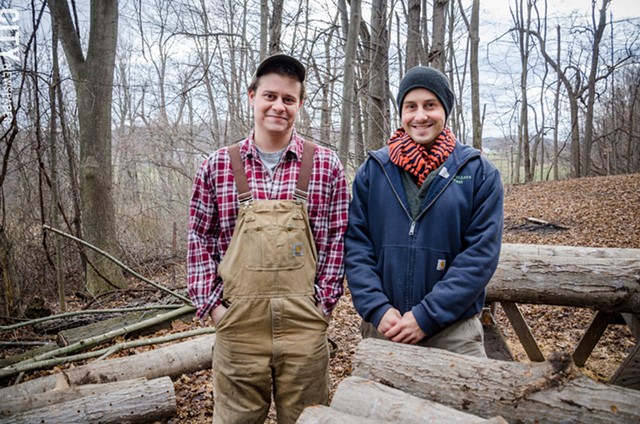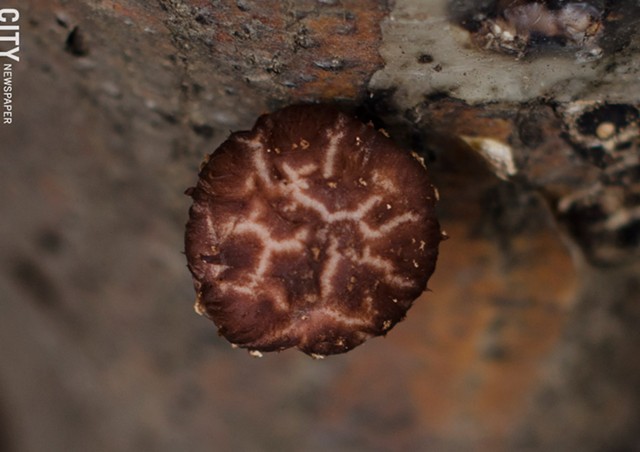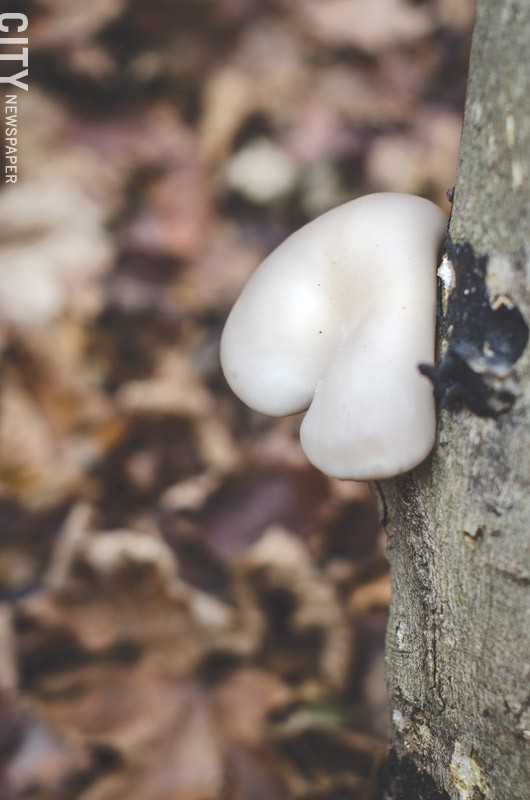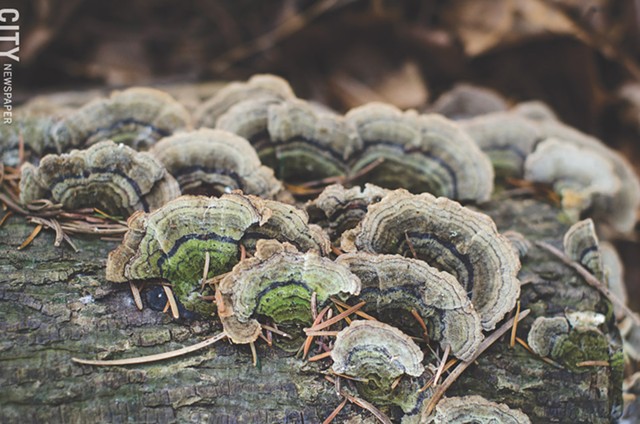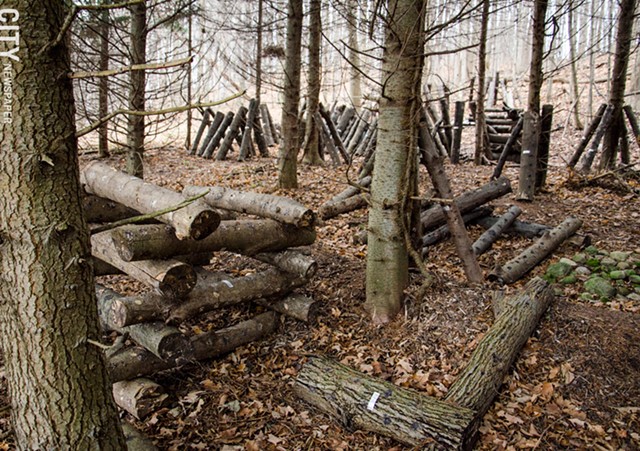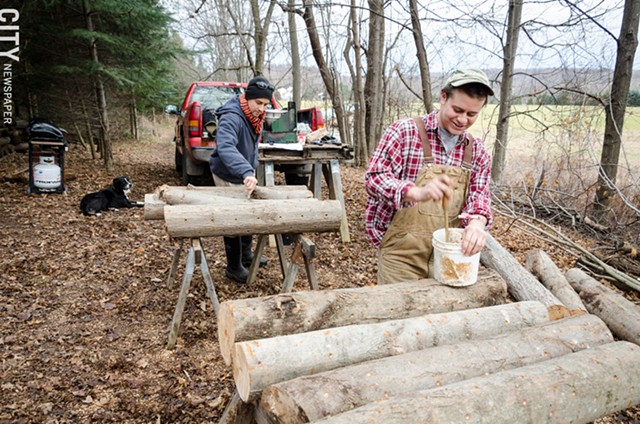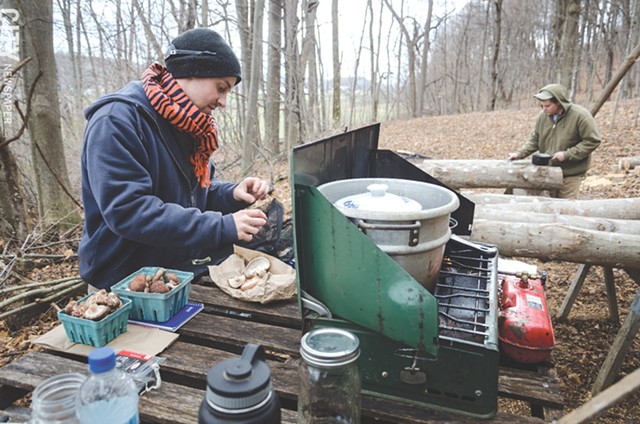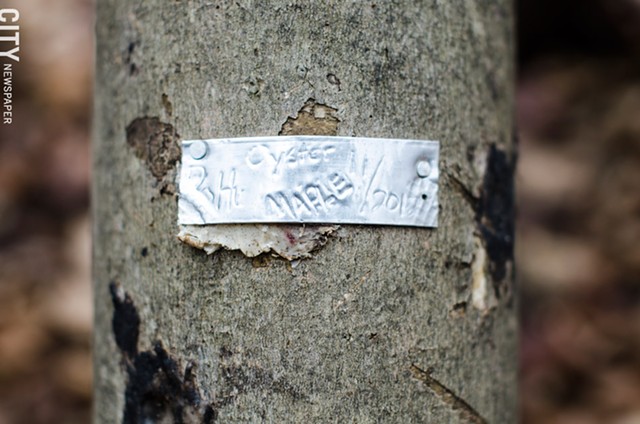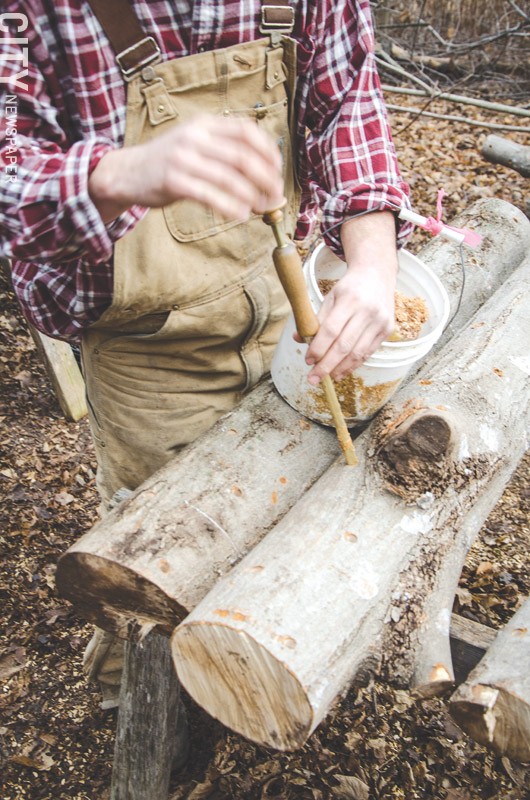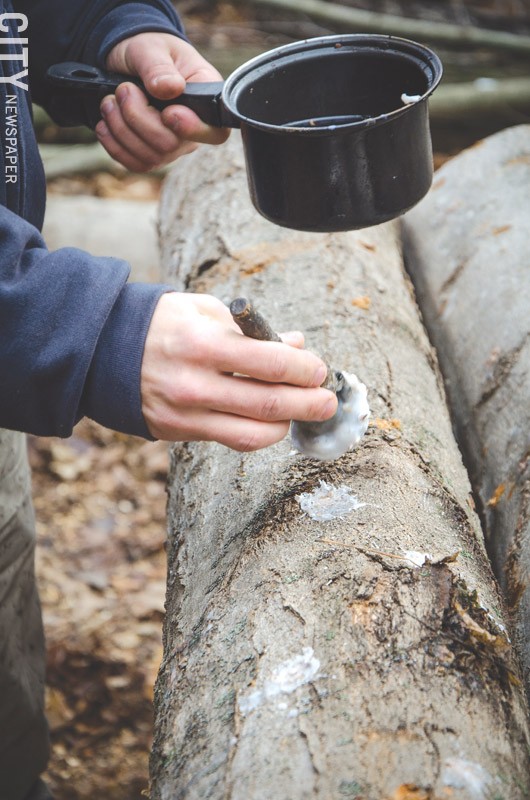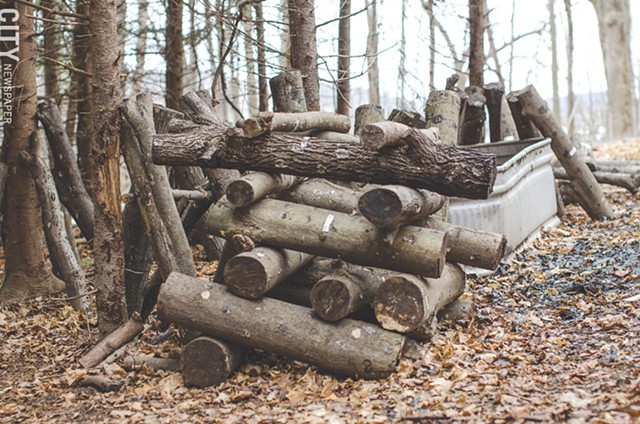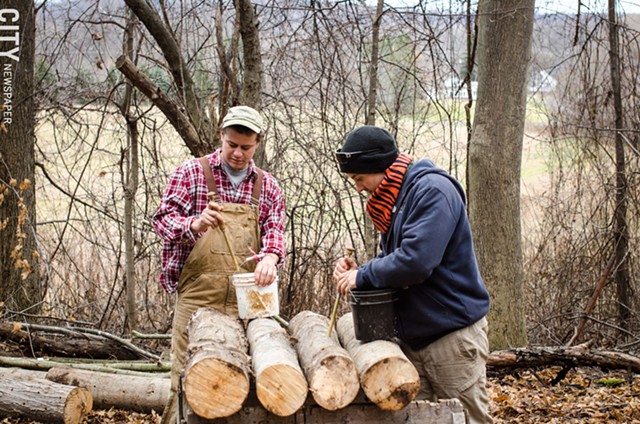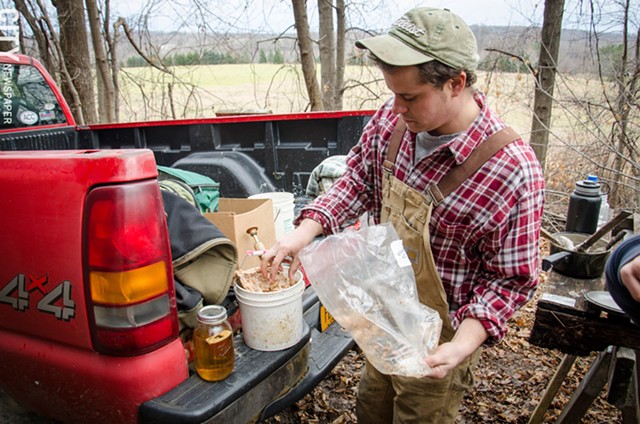
[
{
"name": "500x250 Ad",
"insertPoint": "5",
"component": "15667920",
"parentWrapperClass": "",
"requiredCountToDisplay": "1"
}
]
Brothers Noah and Abram Johnson stood on a perch overlooking their small farm last month, radiating such pride that you'd think they ruled a vast, mighty kingdom. It was an unusually warm day that beckoned insects out of their winter hiding spots to circle in lazy formations over the Johnsons' field.
Noah, 28, and Abe, 26, or the Johnson boys, as they are called by some of their neighboring farmers in this rural part of Wayne County, are the new kids on the block. They started the Johnson Brothers Food Forest, an organic farm of fewer than 10 acres outside of Newark, in 2013.
You won't find livestock or rows of corn on this farm. The nearest barn is across the road and there isn't a tractor in site. The brothers call a weather-worn wooden picnic table their boardroom, and unless you know what to look for, you might not realize that you're standing a few feet from their crop — mushrooms, which they grow in a forest.
The idea of a mushroom farm fascinated the brothers for years, Noah Johnson says.
"We wanted a niche, something of value instead of growing a kind of cheap factory-farmed crop," he says. "We don't grow truffles, but they are one of the most expensive food items you can eat, and a lot of mushrooms fall into a similar category. Mushrooms have high market value."
The more they learned about mushrooms, he says, the harder it became to resist focusing all of their energy on them.
"There's been some research that suggests that mushrooms have some anti-cancer benefits, and we've had a number of members of our family and a lot of people we know who have had to deal with that," Noah Johnson says. "If we can encourage more people to eat mushrooms, maybe that's a good thing."
And mushrooms are nature's recyclers. They're great at breaking down broken branches, he says, and rotting wood on the forest floor, converting it into rich compost-like soil.
Though mushrooms are typically found them in the vegetable displays in grocery stores, they're not vegetables. Mushrooms are fungi and humans have been consuming them in a variety of ways, everything from stews to teas, for thousands of years. Some European and Eastern cultures believed they possessed healing, even mystical properties.
Low in calories and carbs, mushrooms are rich in vitamins C and D, and especially the B's such as riboflavin, niacin, and pantothenic acid, which support the nervous system. They're also high in minerals such as selenium and copper.
Noah and Abe grow several varieties of mushrooms, but about 80 percent of their crop is shiitake: primordial-looking gems prized for their rich, smoky flavor.
"We grow mostly shiitakes, but we grow a wide range of them," Abe Johnson says. "They are one of the more popular specialty mushrooms. They can stand a light frost. As it gets really cold they just stop growing. They don't die; they just stop."
They also grow some oyster, a bone-colored gilled mushroom that is among the most widely eaten in the world, and wine caps, which can grow quite large.
The brothers don't grow chaga, but they do gather it from their forest. Chaga is sometimes referred to as the diamond of the forest and grows on trees.
"Chaga is actually a wild mushroom that we hunt and find even in winter," Abe Johnson says. "It's hard and charcoal-looking, one that people like to use for tea. It's great, very light with a hint of vanilla."
The Johnsons are also experimenting with growing a number of lesser-known mushrooms such as turkey tail, chicken of the woods, maitake, and lion's mane.
"Lion's mane looks like a puff ball with spaghetti-like strands that hang," Abe Johnson says. "It's a tooth fungus."
They've managed to get lion's mane to the fruiting stage, they say, but not to the point where it can be harvested consistently.
There are several ways that mushrooms are grown commercially, often in barns, cellars, and covered dugouts. The Johnsons, however, take a more unusual route: they're farming on logs in forest beds.
Along the higher elevation of their farm is a grove of evergreens, mostly pines. Throughout the small grove, logs are neatly arranged in formations, some resembling teepees while others are stacked in a crisscross pattern. The formations are roughly 3- to 4- feet wide and not much more than 3 feet tall. If you didn't know what the Johnsons are up to, you might think they're building little shelters for critters of one sort or another.
Farming mushrooms on logs is nothing new; it's a technique that's been around for years, but it's a laborious process that requires time, patience, and a bit of luck. In some ways, the Johnsons say, it's similar to the stamina that vintners need to arrive at a fine root stock and a good grape.
"We started with trees that needed to be thinned out," Noah Johnson says. "We used mostly maple because there are a lot them on the property that were overcrowded, and we used a bow saw and hatchet to bring them down."
Once the trees are down, the brothers wait a month to let the anti-fungal properties wear off. Then they cut the logs into 3- to 4- foot lengths.
"We then drill holes in them and those holes are filled with a sawdust-and-spawn mixture and after that, wax is put over the top of the holes to keep the bugs out," Noah Johnson says. "Then we wait a year."
The spawn in mushroom-speak is a seed culture that will eventually fill the inside of the log with mycelium, a creepy, fuzzy-looking web of thread-like roots, which is the vegetative body of the fungus. In time, the mass will take over the log.
It's an amazing relationship that's reminiscent of the sci-fi thriller, "Invasion of the Body Snatchers" since the log appears pretty normal on the outside until the tiny mushroom heads or pins begin sprouting through the bark. By then the log is more fungus than cut maple.
Abe Johnson points to some drill holes.
"Here's where we inoculated and you can see that it's spreading," he says, pointing to the emerging pins, which look a bit like small finishing nails. "The mushrooms are really more like the apples on an apple tree. At this point, there is the vegetative part inside the log. The mushrooms are the fruiting section."
Metal tags are tacked to each log, serving as labels that detail the type of mushroom that the log has been inoculated with and when, Abe Johnson says.
It takes anywhere from a year to a year-and-a-half before the logs start producing, sometimes longer depending on the variety of mushroom. And they'll continue to produce for anywhere from five to 10 years, he says, depending on growing conditions.
"The fruiting range for shiitake is from 45 degrees to 85 degrees," Noah Johnson says. "During the hot wet summer months, the mushrooms grow faster so we harvest twice a day by hand with a small knife."
An old-growth forest that's cool with dappled sunlight is the ideal environment, Noah Johnson says, and the natural habitat for many mushrooms.
"The older the wood, the bigger the trees, and the more diversity there is in the trees, these things will allow for different types of fungus to grow," he says.
The worst thing for mushrooms, he says, is hot, dry wind. And there are pests, too, mainly in the form of slugs. The slimy little gastropods can do a lot of damage quickly.
But the brothers don't spend much time worrying about pests or trying to control unfavorable growing conditions. In addition to their organic, no-chemicals approach to farming, they're also devotees of permaculture.
The practice was explored in various forms during much of the last century, especially as some parts of the world, such as Australia, dealt with fresh-water scarcity.
Permaculture is both a philosophical and scientific approach to land use that holds respect for the planet above all else. And it relies on observing how natural ecosystems function, understanding their synergy, and then designing sustainable land and water use for that environment, whether it's a landscape, a building, or a farm.
The Johnsons are certified in designing self-sustaining permaculture growing conditions.
"In permaculture theory there is this thinking that the problem is also the solution," Noah Johnson says. "Too many slugs can mean that you really have a deficiency in something else. If we had to, we would probably use animals to do our pest control. Ducks will eat the slugs and spend most of their time patrolling the mushroom yards."
Nature becomes the instructor in permaculture, Abe Johnson says. Rather than resort to pesticides and chemicals when they encounter a problem, he says, the brothers step back and observe.
"Those bugs are there for a reason; something is there in excess that they're taking advantage of," he says. The bugs can be part of the solution, he says. In one such instance, the brothers discovered that they could use their wine cap mushrooms as bait to protect their more valuable crop, shiitakes, from insects.
And the brothers don't irrigate their farm, either.
"We want to have control of our watershed," Noah Johnson says. "It's a big deal for us."
The brothers dug a small ditch to catch rainwater in the middle of their mushroom forest. A small berm of earth on the north side of the ditch helps to hold and distribute the water into the ground.
"This goes into our groundwater to fill up our aquafers so we don't have to irrigate," Abe Johnson says. "Eventually it drains downward into the fields. Even the logs we bring down will eventually send nutrients into the ground that are spread naturally. It all works together."
Warding off pests and creating a natural irrigation system, however, are not the Johnson brothers' biggest challenges; survival in today's ag industry can be something of a colossal feat.
When people talk about the Rust Belt, they're usually referring to closed factories and lost manufacturing jobs; it become the image of economic decline that much of Upstate New York is still trying to shake off.
But there's another image: rural Upstate with barns leaning, ready to collapse, and rusting farm machinery sitting in fields. During much of the last four decades, many small family farms were either bought by larger farms or the families just left the business. Going into farming today strikes some old-time farmers as foolhardy.
When the Johnson brothers told their parents that they were starting a small farm, mushroom farming no less, they say that their reaction wasn't exactly like telling them they were joining the circus, but it wasn't far off, either.
David Stern, an organic farmer who has been in the business for more than 40 years, knows the Johnsons. He says that he doesn't like to discourage people from going into farming, but that he's honest with them, anyway.
"I don't recommend going into agriculture," he says. "A lot of farms go out of business every day and no one even blinks an eye."
When people come to him for advice, as they often do, he says that he has three questions for them:
"How old are you? What is your debt? And who's coming along behind you?" he says.
Stern, who's in his 60's, says that youth and physical fitness are important. If you injure yourself, he says, your farm business is in trouble.
And farming often means taking on a lot of debt, he says, and some people don't have the stomach for that.
"You have to learn how to incorporate disaster," Stern says. "Some of the crops here have started to bud (because of the warm December). We may never even get a single blueberry in the summer because of it, but we have to go on nurturing those bushes."
And as a farmer ages, he says, you need younger family members who can take over the business.
"But a lot of kids are not willing to do it because it's too hard," Stern says.
But there are some signs, however faint, that prospects for farmers may be changing. After a 70-year decline in the number of small farms, the Washington Post reported recently that the number of farms in the US increased by 4 percent between 2002 and 2007, mostly due to small farmers. And it appears as though the trend is holding.
"We've seen a definite increase in the number of organic certifications," says Nancy Apolito, interim director of the Northeast Organic Farming Association. "We're at the highest level of membership in years."
Noah and Abe Johnson say that they know what they've gotten themselves into; they've been around farming all of their lives.
"Our grandfathers on both sides were farmers growing potatoes and apples," Noah Johnson says. "And we've worked on all different kinds of farms."
They've continued to work other jobs to support themselves while starting the farm, though they say they'll transition to working full time on the farm in the spring. And they've used mushrooms as a kind of springboard to expand.
"Mushrooms are making the money we need for our fruit trees, nut trees, vegetables, and herbs," Abe Johnson says. "The safety in permaculture is diversity. If one thing kind of fails or is slower, then you have other things that will make up for it."
They've also kept their expenses to a minimum. For instance, instead of attempting to purchase their own land, they sublease land from Peacework Farm, an organic farm which is based on a community-supported agricultural model. The Johnsons also sell their mushrooms through Peacework. Their prices vary, but they get about $5 per quart for their shiitakes.
Peacework leases its farmland from the Genesee Land Trust, whose mission is to preserve and protect natural lands and waterways. The organization oversees roughly 4,800 acres in Monroe, Wayne, Livingston, and Ontario counties. Generally, CSA's are membership farms. The advantages for CSA customers are easy access to farm-fresh organic items, variety and diversity, and knowing the local source of the food and how it's grown.
The Johnsons have a similar relationship with Upstate Collective. The main advantages to these kinds of relationships for farmers are more time for farming rather than distributing the produce, and they can sell more produce to targeted audiences.
Noah Johnson says that their business plan is not wedded to expanding their farm so much in acreage as it is to continue creating niche crops. This will also keep their costs down, he says, while building revenue.
Elizabeth Henderson, co-founder of Peacework Farm, says that the Johnson brothers are on the right track. Henderson would know. She wrote the book "Sharing the Harvest," which many consider to be the gold standard in community-supported organic farming.
"I think they're definitely part of a really healthy trend," she says. "In this era of climate change, this is the kind of agriculture we need."
If we want to keep the planet from further warming, Henderson says, we need to grow organic produce and buy it. Large amounts of fossil fuels are needed to create chemical fertilizers.
"We need to bring thousands of Johnson brothers into small organic farming," she says.
Henderson and others say that farming is a lifestyle choice that has become more attractive to some young people. She tells new farmers that if they can learn to live with less money and material things, that it can be strangely liberating.
The Johnsons agree; it's the lifestyle that motivates them, they say.
"We are trying to create the kind of farm where the work we're doing is work we enjoy doing and not torturing us," Abe Johnson says. "We don't take days off, but that's farming. Sometimes I'm out here in the dark. But nothing thrills me more than when someone says our mushrooms are the best-tasting mushrooms they've ever eaten."
He says that the key is not letting what other people think of farming limit their imagination. And they allow themselves to make mistakes.
"We dug a pond once that wouldn't hold water," Abe Johnson says. "We still hope one day it will work. It does fill up, but then it doesn't hold. But the frogs like it."
Speaking of...
-

Local projects get state funds
Dec 20, 2017 -
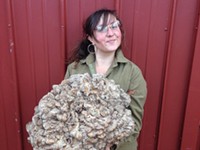
Smugtown wants you to consider the mushroom
Nov 15, 2017 - More »
Latest in News
More by Tim Louis Macaluso
-

RCSD financial crisis builds
Sep 23, 2019 -

RCSD facing spending concerns
Sep 20, 2019 -

Education forum tomorrow night for downtown residents
Sep 17, 2019 - More »
